Eclipses
 Eclipses are among the most spectacular natural phenomena. During a lunar eclipse, the brilliant full Moon often darkens to a rusty red. A lunar eclipse occurs when the Moon passes through Earth’s shadow. This can happen only when the Sun, Earth, and the Moon are in a straight line at full Moon. During a solar eclipse, broad daylight is transformed into an eerie twilight, as the Sun seems to be blotted from the sky. A solar eclipse occurs when the Moon’s shadow moves across Earth’s surface. As seen from Earth, the Moon moves in front of the Sun—a new Moon.
Eclipses are among the most spectacular natural phenomena. During a lunar eclipse, the brilliant full Moon often darkens to a rusty red. A lunar eclipse occurs when the Moon passes through Earth’s shadow. This can happen only when the Sun, Earth, and the Moon are in a straight line at full Moon. During a solar eclipse, broad daylight is transformed into an eerie twilight, as the Sun seems to be blotted from the sky. A solar eclipse occurs when the Moon’s shadow moves across Earth’s surface. As seen from Earth, the Moon moves in front of the Sun—a new Moon.
1-12 Eclipses do not occur during every new or full Moon phase
At first glance, it would seem that eclipses should happen at every new and full Moon, but in fact, they occur much less often because the Moon’s orbit is tilted 5° from the plane of the ecliptic (Figure 1-25). Consequently, the new Moon and full Moon usually occur when the Moon is either above or below the plane of Earth’s orbit. In such positions, a true alignment between the Sun, Moon, and Earth is not possible. Hence, Earth and the Moon do not enter each others’ shadows and an eclipse cannot occur. This tilt also explains why, as mentioned earlier, the new Moon is often seen as a thin crescent—we see “under” or “above” it to a tiny sliver of the sunlit side.
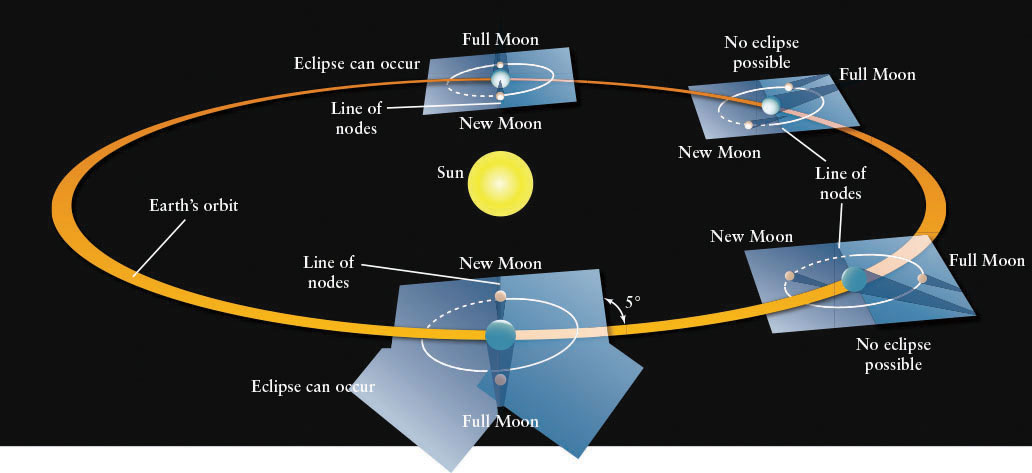
 Conditions for Eclipses The Moon must be very nearly on the ecliptic at new Moon for a solar eclipse to occur. A lunar eclipse occurs only if the Moon is very nearly on the ecliptic at full Moon. When new Moon or full Moon phases occur away from the ecliptic, no eclipse is seen because the Moon and Earth do not pass through each other’s shadows.
Conditions for Eclipses The Moon must be very nearly on the ecliptic at new Moon for a solar eclipse to occur. A lunar eclipse occurs only if the Moon is very nearly on the ecliptic at full Moon. When new Moon or full Moon phases occur away from the ecliptic, no eclipse is seen because the Moon and Earth do not pass through each other’s shadows.
Indeed, because its orbit is tilted 5° from the ecliptic, the Moon is usually above or below the plane of our orbit around the Sun. The Moon crosses the ecliptic at what is called the line of nodes (see Figure 1-25). An eclipse takes place only when the Moon crosses the plane of the ecliptic during its new or full phase. By calculating the number of times a new Moon takes place on the line of nodes, we find that at least two and no more than five solar eclipses occur each year. Lunar eclipses occur just about as frequently as solar eclipses, with the maximum number of eclipses (solar plus lunar) possible in a year being seven.
1-13 Three types of lunar eclipse occur
Earth’s shadow has two distinct parts, as shown in Figure 1-26a. The umbra is the part of the shadow where all direct sunlight is blocked by Earth. If you were in Earth’s umbra looking at Earth, you would not see the Sun behind it at all. The penumbra of the shadow is where Earth blocks only some of the sunlight. If you were in Earth’s penumbra looking at Earth, you would see a crescent Sun behind it. The Moon has an analogous umbra and penumbra.
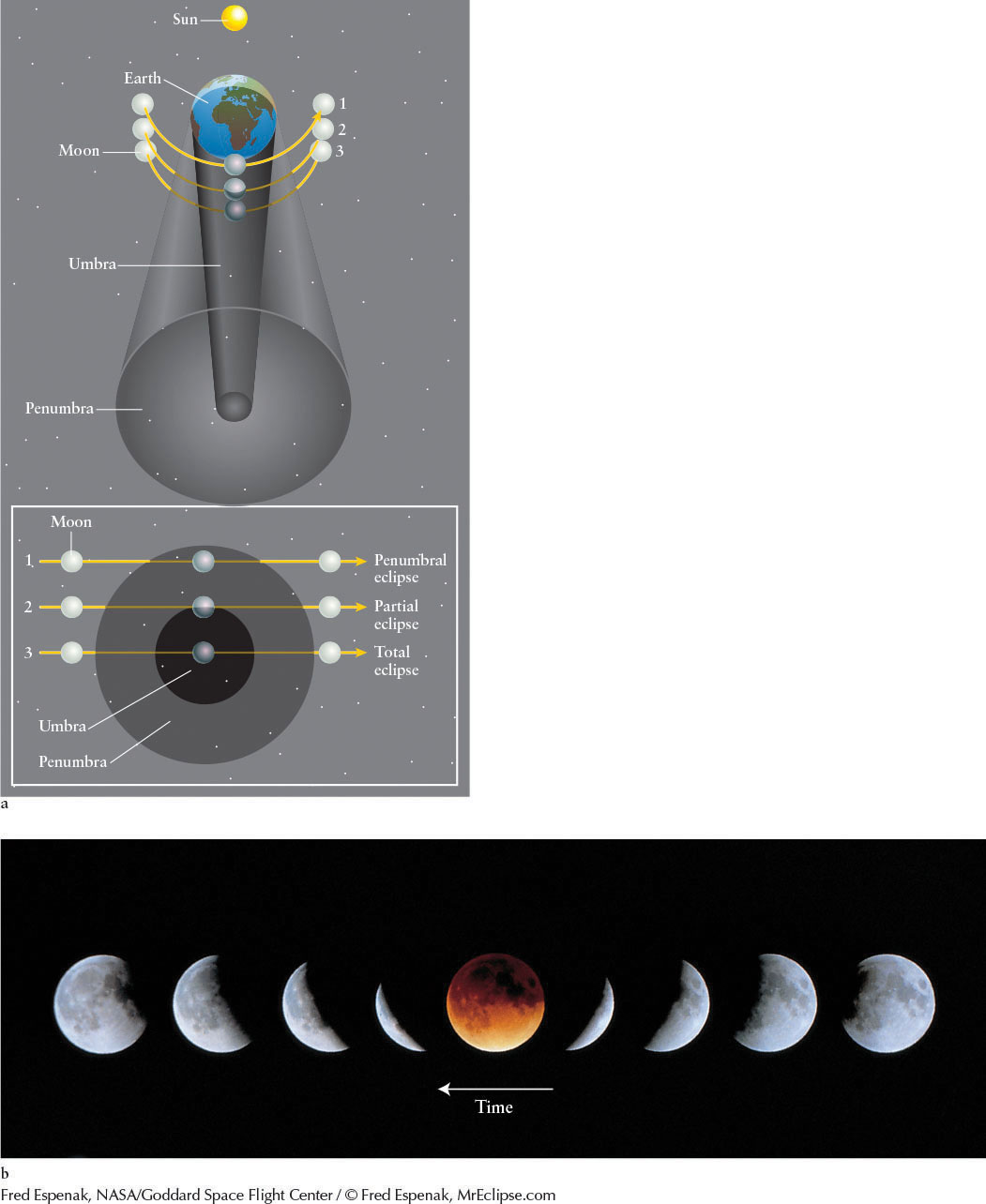
29
Depending on how the Moon travels through Earth’s shadow, one of three kinds of lunar eclipse may occur. A penumbral eclipse, when the Moon passes through only Earth’s penumbra, is easy to miss. The Moon still looks full, just a little dimmer than usual and sometimes slightly reddish in color (path 1 in Figure 1-26a).
When just part of the lunar surface passes through the umbra, a bite seems to be taken out of the Moon, and we see a partial eclipse (path 2 in Figure 1-26a). When the Moon travels completely into the umbra, we see a total eclipse of the Moon (path 3 in Figure 1-26a). Total lunar eclipses with the maximum duration, lasting for up to 1 hour and 47 minutes, occur when the Moon is closest to Earth and is traveling directly through the center of the umbra. Table 1-2 lists all the total and partial lunar eclipses from 2014 through 2017.
| Date | Visible from | Type | Duration of totality (h:min) |
|---|---|---|---|
| 2014 Apr 15 | Australia, Pacific, Americas | Total | 1:18 |
| 2014 Oct 08 | Asia, Australia, Pacific, Americas | Total | :59 |
| 2015 Apr 04 | Asia, Australia, Pacific, Americas | Total | :05 |
| 2015 Sep 28 | Europe, Africa, west Asia, Americas | Total | 1:12 |
| 2016 Mar 23 | Asia, Australia, Pacific, western Americas | Penumbral | |
| 2016 Sep 16 | Europe, Africa, Asia, Australia | Penumbral | |
| 2017 Feb 11 | Europe, Africa, Asia, Americas | Penumbral | |
| 2017 Aug 07 | Europe, Africa, Asia, Australia | Partial |
Margin Question 1-8
Question
Why does the new Moon sometimes appear as a crescent?
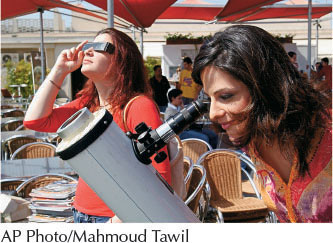
30
Even during a total eclipse, the Moon does not completely disappear. A small amount of sunlight passing through Earth’s atmosphere is bent into Earth’s umbra. The light deflected into the umbra is primarily red and orange, and thus the darkened Moon glows faintly in rust-colored hues (Figure 1-26b). Everyone on the side of Earth over which a lunar eclipse occurs can see it, provided that clouds do not obscure the event. Lunar eclipses are perfectly safe to watch with the naked eye.
1-14 Three types of solar eclipse also occur
The different physical diameters of the Sun and Moon and their different distances from us combine so that they have nearly the same angular diameter as seen from Earth—about ½°. When the Moon completely covers the Sun, the result is a total solar eclipse. You can see in Figure 1-27 that only the tip of the Moon’s umbra ever reaches Earth’s surface. As Earth turns and the Moon orbits, the tip traces an eclipse path across our planet. Only people within these areas are treated to the spectacle of a total solar eclipse, which is why cruise lines love solar eclipses. During those few precious moments, hot gases (the solar corona) surrounding the Sun can be observed and photographed (Figure 1-28). By studying the light from the outer layers of the Sun, astronomers have been able to learn about its atmospheric temperature, chemistry, and gas activity.
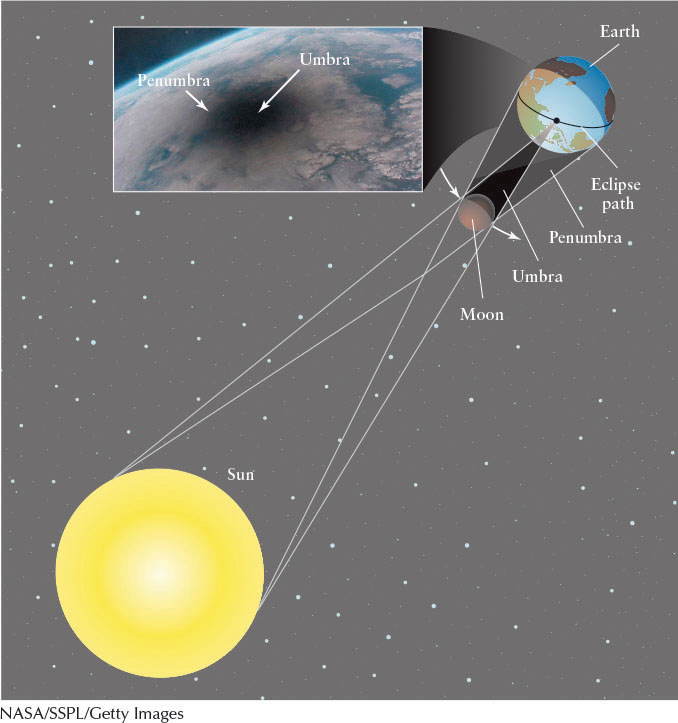
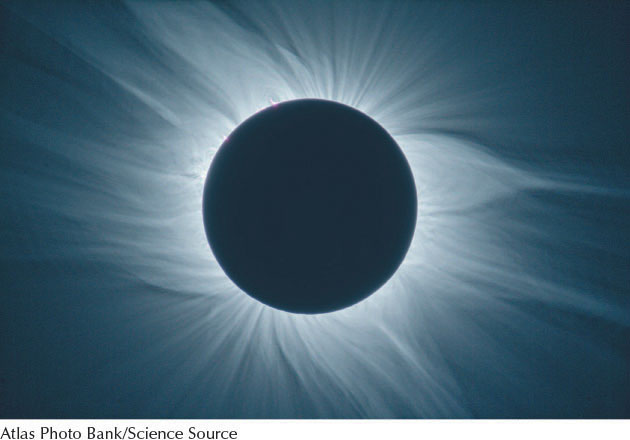
Viewing the Sun directly for more than a moment at any time without an approved filter causes permanent eye damage. It is only safe to look at a total solar eclipse without a filter during the brief time when the Moon completely blocks the Sun. At all other times during the eclipse, you must view it either through an approved filter or in the image made on a flat surface by a telescope or a pinhole camera (see margin photographs).
31
Earth’s rotation and the orbital motion of the Moon cause the umbra to race along the eclipse path at speeds in excess of 1700 km/h (1050 mi/h). For this reason, complete blockage of the Sun (totality) during a total eclipse never lasts for more than 7½ minutes at any one location on the eclipse path, and it usually lasts for only a few moments.
The Moon’s umbra is also surrounded by a penumbra (see Figure 1-27). The photograph in Figure 1-27 shows the dark spot produced by the Moon’s umbra and the less dark penumbral ring surrounding it on Earth’s surface during a total solar eclipse. During a solar eclipse, the Moon’s penumbra extends over a large portion of Earth’s surface. When only the penumbra sweeps across Earth’s surface, as happens in high latitude regions, the Sun is only partly covered by the Moon. This circumstance results in a partial eclipse of the Sun. Similarly, people in the penumbra of a total eclipse see a partial eclipse. In either case, the Sun looks crescent-shaped as seen from Earth. Never look directly at a partial solar eclipse.
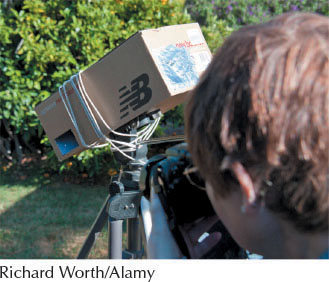
The Moon’s orbit around Earth is oval shaped. Therefore, the distance between Earth and the Moon, which averages 384,400 km (238,900 mi), varies by 14% as the Moon moves around Earth. Consequently, the angular size of the Moon in our sky varies by that amount. The width of the eclipse path depends primarily on the Earth-Moon distance during an eclipse. The eclipse path is widest—up to 270 km (170 mi)—when the new Moon happens to be at the point in its orbit nearest Earth. Usually, however, the path is much narrower.
32
If what would otherwise be a total solar eclipse occurs when the Moon is relatively far from Earth, then the Moon’s umbra falls short of Earth and no one sees a total eclipse. From Earth’s surface, the Moon then appears too small to cover the Sun completely, and a thin ring or “annulus” of light is seen around the edge of the Moon at mid-eclipse. This type of eclipse is called an annular eclipse (Figure 1-29). The length of the Moon’s umbra is nearly 5000 km (3100 mi) shorter than the average distance between the Moon and Earth’s surface. Thus, the Moon’s shadow often fails to reach Earth, making annular solar eclipses slightly more common than total solar eclipses. Table 1-3 lists all the total, partial, and annular solar eclipses from 2014 through 2017. It is never safe to look directly at a partial or annular eclipse. Figure 1-30 shows the paths over Earth of all the total and annular eclipses through 2020.
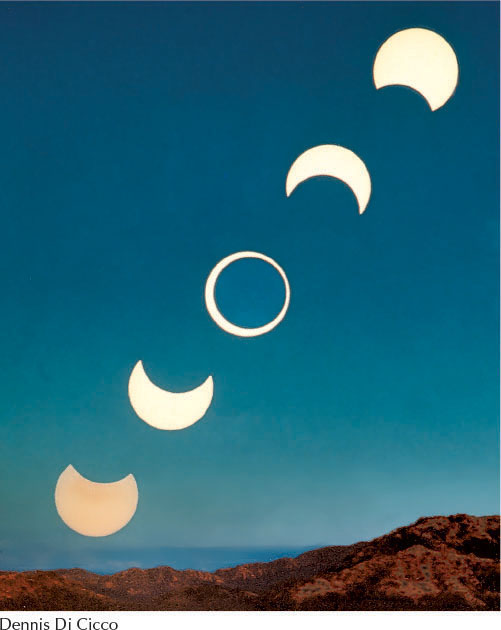
| Date | Type | Visible from | Total/annular eclipse time (min:sec) |
|---|---|---|---|
| 2014 Apr 29 | Annular | Antarctica | :49 |
| 2014 Oct 23 | Partial | North America | |
| 2015 Mar 20 | Partial/Total | Partial: Iceland, Europe, northern Africa, northern Asia Total: north Atlantic Ocean | 2:47 |
| 2015 Sep 13 | Partial | Southern Africa, Antarctica | |
| 2016 Mar 09 | Partial/Total | Partial: eastern Asia, Australia Total: Pacific Ocean, Borneo | 4:09 |
| 2016 Sep 01 | Annular | Atlantic Ocean, central Africa, Indian Ocean | 3:06 |
| 2017 Feb 26 | Annular | Pacific Ocean, Chile, Argentina, Atlantic Ocean, Africa | 0:44 |
| 2017 Aug 21 | Partial/Total | Partial: northern South America, all of North America except United States Total: United States | 2:40 |
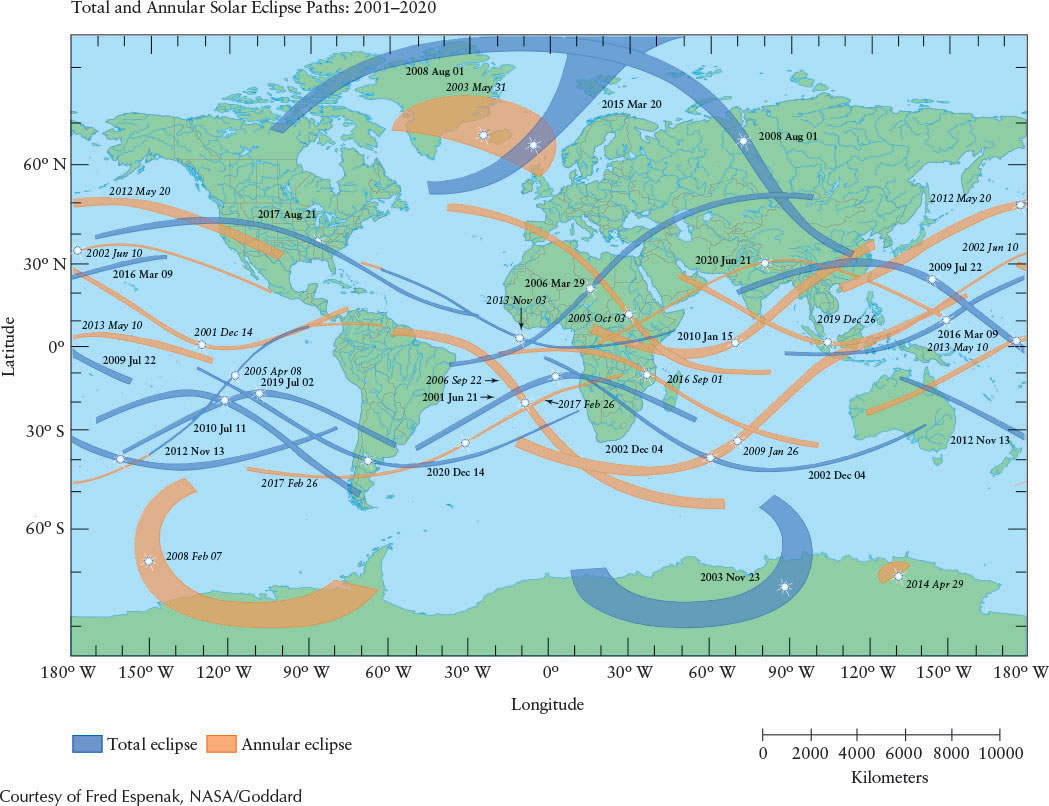
Margin Question 1-9
Question
Why aren’t there any annular lunar eclipses?
Margin Question 1-10
Question
Why are some of the paths in Figure 1-30 wider than others?
A total solar eclipse is a dramatic event. The sky begins to darken, the air temperature falls, and the winds increase as the Moon’s umbra races toward you. All nature responds: Birds go to roost, flowers close their petals, and crickets begin to chirp as if evening had arrived. As the moment when the Sun becomes totally eclipsed approaches, the landscape is bathed in shimmering bands of light and dark as the last few rays of sunlight peek out from behind the edge of the Moon. Finally, the corona blazes forth in a starstudded daytime sky. It is an awesome sight, but always take care in viewing it.
33
1-15 Frontiers yet to be discovered
In this chapter we have examined several factors that explain the changing seasons on Earth. Geologists have discovered a variety of cycles of global temperature change that have occurred over the history of Earth. Indeed, they have found that Earth suffered several periods of global freezing. Historically, these changes occur over tens of thousands of years, hundreds of thousands of years, and possibly longer cycles. The causes of these cycles are still being studied. Conversely, we are now undergoing a global warming. Most scientists are now convinced that the present climate change is a result of a combination of human and other causes, some of which have yet to be discovered.